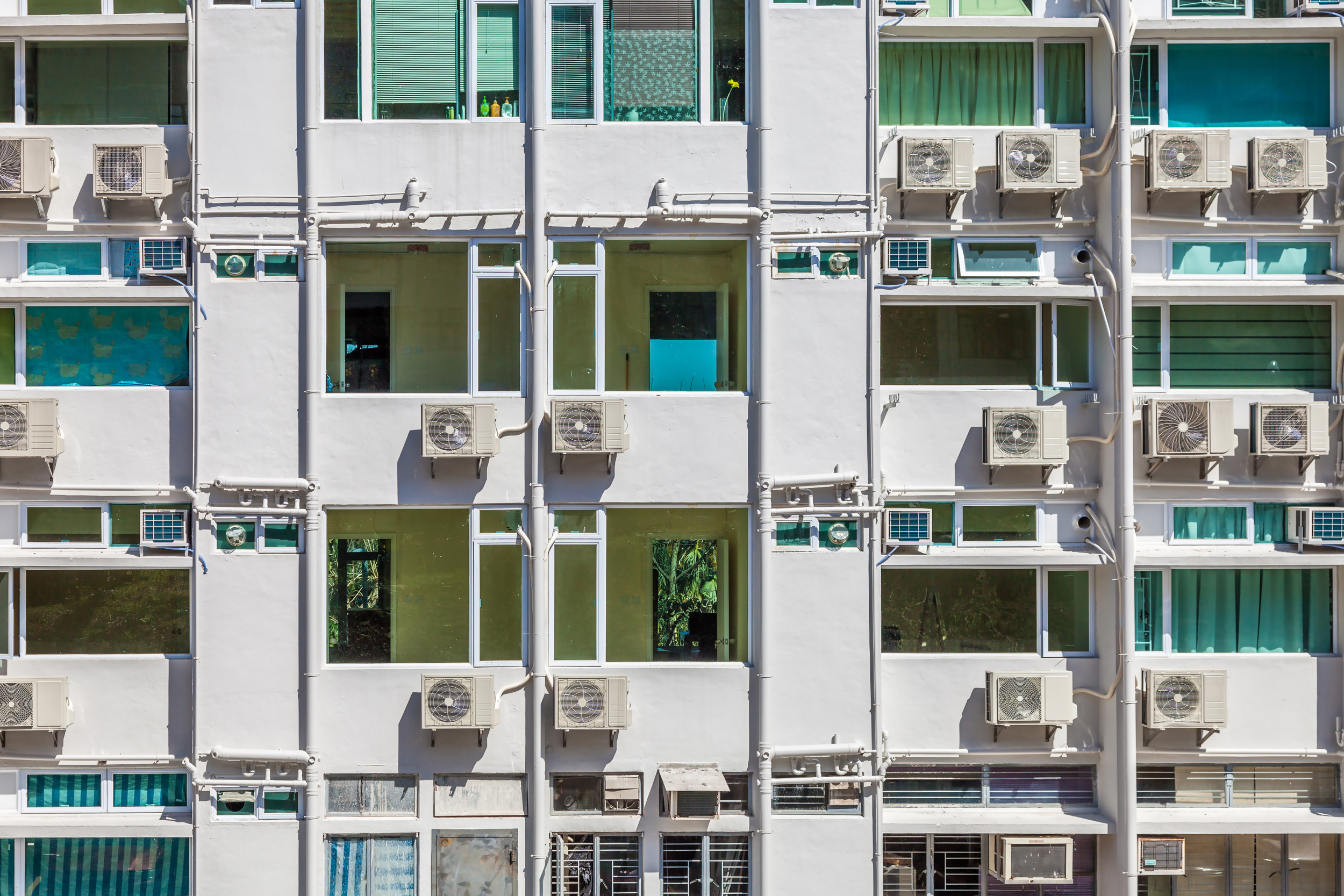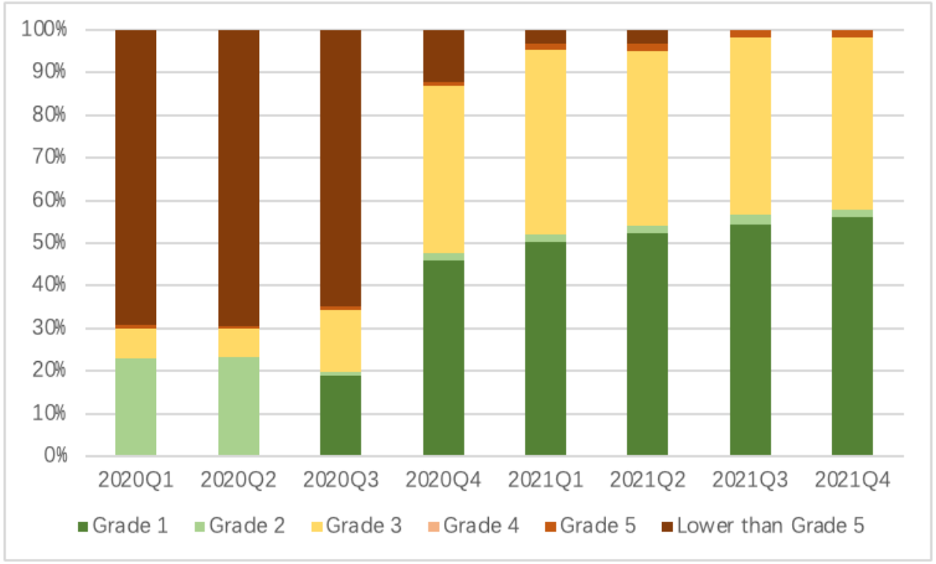
Revolutionizing Cooling and Climate: China’s Pioneering AC Efficiency Standards
Summary: In 2020, China committed to a momentous environmental goal: reaching peak carbon emissions by 2030 and achieving carbon neutrality by 2060. Central to this ambition is a drive for high efficiency appliances, including room air conditioners (RACs). In 2020 China implemented a world-leading RAC energy efficiency standard (GB 21455-2019). The policy is rapidly transforming the market, relegating inefficient models from a 69% market share1 to near-elimination and propelling Grade 1 appliances2 (the highest efficiency level) to a 56% market share by the end of 2021.3 The RAC policy is so effective that if all developing countries were to adopt RAC policies similar to current Chinese policies, they would avoid a cumulative 2,322 Mt of CO₂ emissions through 2030.
Challenge: Cooling-related electricity demand and resulting CO2 emissions pose a substantial challenge in China. During the summer heatwave of 2021, the need for cooling pushed China’s electricity demand to record highs, with RACs accounting for about 30% of the peak summer load in some large and medium-sized Chinese cities. Many cities had to cut power supply to the industry and business sectors to meet residential electricity needs.4
Prior to 2019, the regulatory landscape for RACs comprised two distinct Minimum Energy Performance Standards (MEPS): GB12021.3-2010 for fixed-speed (FS) ACs, and GB 21455-2013 for variable-speed (VS) ACs.5 However, having two separate standards for FS and VS RACs, with a much lower MEPS for FS, enabled inefficient FS RACs to remain on the market. By 2019 the efficacy of both MEPS had waned, failing to mirror the strides in efficiency fostered by rapid technological advancement.
Solution: In 2019, China initiated the development of new RAC MEPS to promote the adoption of more efficient ACs for both fixed and variable speed ACs. This aligned with China’s ambitious Dual Carbon pledge of peaking carbon emissions by 2030 and achieving carbon neutrality before 2060.
To action this, China formed a working group to draft new MEPS. This multi-stakeholder group comprised of the China National Institute for Standardization (CNIS), China’s leading appliance research institutes, international NGOs, leading test labs, and the top 20 largest AC manufacturers. The working group supported China’s commitment to the Paris Agreement, Kigali Amendment to the Montreal Protocol, and China’s goal to become the world leader in appliance energy efficiency standards. It focused on the following guiding principles:
- Grade 1 of the new label must be world-leading.
- The increase in the MEPS stringency should be large enough to eliminate low-efficiency fixed-speed products from the market.
- The new standard should take into account the transition from high-GWP refrigerants to low-GWP ones.
The working group conducted extensive research and technical studies to understand the current market dynamics, the status of energy efficiency, and the technology improvement potential. Based on the research findings, the working group drafted a new AC MEPS in March 2019 and published the draft for public consultation among key stakeholders. In May 2019, a final draft was submitted to the Standardization Administration of China for final approval. After completing the MEPS development and review process, China issued new RAC MEPS in 2019 that were implemented in mid-2020.
The 2019 RAC MEPS brought about a significant shift by unifying energy efficiency criteria for both fixed-speed and variable-speed ACs, concurrently elevating the minimum efficiency standard by 13%.
Impact
The implementation of the new MEPS resulted in the following improvements:
- World-Leading MEPS: The newly established MEPS in China achieved global prominence, notably the inverter MEPS reached the highest CSPF at 6.1 W/W.
- Swift Energy Efficiency Transformation: Following MEPS implementation, the Chinese room AC market underwent rapid energy efficiency grade transformation. This led to the near-elimination of products with less than Grade 5 efficiency and a substantial rise in Grade 1 appliances (Figure 1) within two years.
Figure 1: Energy Efficiency Transformation of RACS in China from 2020 to 2021

- Market Influence on Low GWP Refrigerants: The introduction of the new MEPS also influenced a market transition toward the adoption of environmentally friendly refrigerants, notably the increased adoption of R32 refrigerant (GWP 675), which achieved an 83.1% market share by 2021, alongside the emergence of R290 (GWP 3). In contrast, the market share of R410A (GWP 1890) diminished to 16.9%, while R22 (GWP 1810) faced a significant reduction and eventual phase-out from the market.
Lessons Learned
China’s adoption of the new AC MEPS provides a roadmap for other regions that want to set similarly ambitious AC MEPS, specifically:
- A strategic vision is crucial for achieving ambitious policy goals related to energy efficiency and sustainability. China’s commitment to ambitious RAC standards is linked to China’s “National Green and High-efficiency Cooling Action Plan” issued in June 2019. The national plan has set up ambitious policy goals related to progressing commitments to the Paris Agreement and Kigali Amendment and increasing the green and high-efficiency cooling products by more than 40%, which produces annual electricity savings of 400 tWh.
- Collaboration between policymakers, technical experts, and industry is crucial for the successful development of standards. China’s success in developing the new MEPS was driven by a combination of efforts and favorable conditions. The key factors included 1) the political commitment and determination of Chinese policymakers; 2) several technical studies from CNIS, local research institutes, and international NGOs that provided strong evidence that supported the policymakers’ decision; 3) deep engagement with industry in the MEPS research from the outset through the expert working group.
- Data and evidence were crucial in the development of the new RAC MEPS. To support the new MEPS development, CNIS and the local research team collected data on product information from the existing product registration system for energy labels. The up-to-date product information enabled the MEPS development team to understand the current market information, and the best available technologies in the market. Based on the latest market data, the policymakers were able to estimate the impact of the new MEPS.
- Deep engagement of industry in the MEPS development process is also key to the successful adoption of the new MEPS. The MEPS expert group engaged key AC manufacturers such as Gree, Haier, Hitachi and Daikin, in the standard development process. This engagement ensured industry’s inputs were collected, while the policymakers could advocate about benefits of accepting a high-quality MEPS. This accelerated the industry’s readiness to comply with the new MEPS and fostered the long-term environmental sustainability of the AC industry in China.
0. ChinaIOL, “Research Report on Energy Efficiency of Domestic Household RACs in China”, 2022
1. The GB 21455-2019 MEPS imposes five energy efficiency grades covering fixed-speed and variable-speed RACs, with grade 5 as the minimum for fixed-speed units and grade 3 as the minimum for variable-speed units.
2. ChinaIOL, “Research Report on Energy Efficiency of Domestic Household RACs in China”, 2022
3. Servitisation of the Cooling Industry: Cooling as A Service White Paper, Clean Cooling Collaborative (CCC), February 2022
4. The evaluation framework under GB12021.3-2010 used the Energy Efficiency Ratio (EER), calculated as the ratio of rated cooling capacity (CC) to rated cooling power consumption. Meanwhile, GB 21455-2013 used the Seasonal Energy Efficiency Ratio (SEER) for cooling-only products and an Annual Performance Factor (APF) for products that heat and cool, namely heat pumps.
